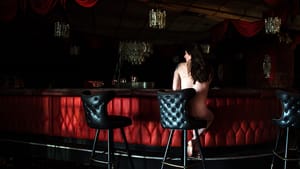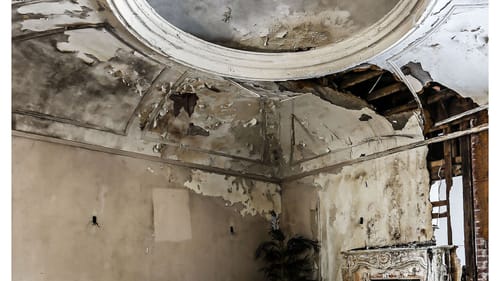Stay in the Loop
BSR publishes on a weekly schedule, with an email newsletter every Wednesday and Thursday morning. There’s no paywall, and subscribing is always free.
Being there
DaVinci Art Alliance presents Sarah R. Bloom's 'The Impermanence of Being'

A viewer could wander at random through Sarah R. Bloom’s DaVinci Art Alliance photography exhibit, The Impermanence of Being, drifting toward the most compelling images. But then she’d miss the thoughtfully curated arc of 39 self-portraits telling the story of a woman sinking, struggling, and surfacing as she contends with her own fragility and that of the broken world.
Like Rebecca Bunting, the Philadelphia photographer who drowned on June 2, 2018, while shooting inside a storm drain near Roosevelt Boulevard, Bloom favors abandoned locales, shooting in a Pittsburgh factory, a Detroit apartment, or a Pennsylvania motel cabin.
But unlike Bunting and other “urbex” (urban exploration) photographers, Bloom uses these vacant, deteriorating settings as the backdrop for self-portraits. Her photos, usually nude, highlight the distinctions between human and architectural form as well as the evanescence they share.
Beautiful decay
Shot in natural light with a digital camera and an interval timer, Bloom’s tableaux of shredded wallpaper, cracked flooring, and once-grand inns gone literally to seed remind us that everything — including the human body — alters, ages, and crumbles in the end.
By placing herself in the pictures, whether in a posture of repose or apparent anguish, face averted from the viewer or gazing point-blank, Bloom underscores the inevitability of change. Depending on one’s outlook, that can be a source of comfort or existential torment: this, too, shall pass.
Bloom’s titles are worth noting, as they often provide a dose of commentary or context for the images. Apart of Things, the first photograph, intends its pun. At first, it’s hard to locate the human figure curled in a fetal position on a floor patterned with tile and shadows. Bars of dark and light section Bloom’s back in a kind of camouflage, making her a part of the space, an abandoned New York resort. At the same time, she is alien — a solitary, naked human on a ballroom floor long after the music has ceased.
Her artist statement outlines how the photographs “explore my personal struggles with middle age, depression and what I have come to call a ‘life unexpected’ … In the 12 years since I began [shooting self-portraits], there has been the newlywed stage and then end of a marriage, a teenage girl raised, hope restored, and hope lost.”

True grit
Bloom’s stance in the photographs often semaphores despair. She doubles over at the waist, hair disheveled and shielding her face, one hand cradling her head or an arm wrapped around her body as if trying to hold herself together. When clothed, she wears a white slip or nightgown — gossamer garments easily ripped or shed.
In only one image, #11, Moment of Impact, does she face the camera head-on. And it is a startling moment—the artist crouching barefoot in an abandoned house somewhere in Pennsylvania, light from a casement window patching her face, gaze direct and impassive. The moment captures an inner grit in spite of it all.
But the very next picture is another plummet (or near-plummet) into anguish; Bloom shoots herself from behind, leaning over a balcony toward the street below. Though the image is titled Leap and the Net will Appear, the photograph — even if meant as metaphor for the risky leaps that life sometimes demands — stirs up more anxiety than faith.
Indeed, Bloom did not jump — at least, not literally — because there are two dozen more photographs. She is ensnared in branches outside a Pennsylvania house or nearly buried under ropes of dead wire in an abandoned school.
In one, she kneels at the keyboard of a no-longer-grand piano, hands on the broken keys. If she could coax sound, it would be a groan.

Lost or found?
The most haunting images were shot at abandoned psychiatric institutions in Pennsylvania, New Jersey, and New York (nameless and in unspecified locales, like all Bloom’s settings). It’s easy to imagine the women who were — unlike Bloom — not there by their own volition and not free to leave. In Screaming in Place, she kneels on a filthy mattress on a littered floor, face contorted into a howl.
Signs of decay are everywhere: windows stained sulfurous yellow, a rusted Valvoline oil drum, a radial of shattered glass, the grimed bottom of a swimming pool, a carpet of ivy in a graffiti-streaked abandoned mill.
Yet these are not the grunge-meets-glamour shots that fill fashion magazines, in which the squalor of the setting highlights the lushness of the clothes. In Bloom’s portraits, she is as naked as her surroundings, vulnerable to the elements of weather, time, sorrow, and abandonment.
And yet. A few of the final images hold notes of redemption. There is only one, Transmogrification, in which she appears to be smiling; it’s hard to tell because of a blinding spot of light, but her face is tilted up instead of down, and she’s sitting on a chair, not the filthy factory floor. There’s a suitcase at her feet, as if to say there is journeying yet to come.
Image #39, the last in the show, is enigmatically titled When You See Me Again It Won't Be Me. This time, Bloom’s setting is a bar, with black quilted-leather stools and faded red fabric swagging overhead.
She is the sole customer, perched on a stool, head turned as if waiting for someone to arrive, or perhaps watching them leave. Yet she seems content in her solitude, at peace with her transient presence in this place (the bar, the world) where no one stays forever.
What, When, Where
The Impermanence of Being. By Sarah R. Bloom. Through June 17, 2018, at the Da Vinci Art Alliance, 704 Catharine Street, Philadelphia, (215) 550-1446 or davinciartalliance.org.
Sign up for our newsletter
All of the week's new articles, all in one place. Sign up for the free weekly BSR newsletters, and don't miss a conversation.

 Anndee Hochman
Anndee Hochman